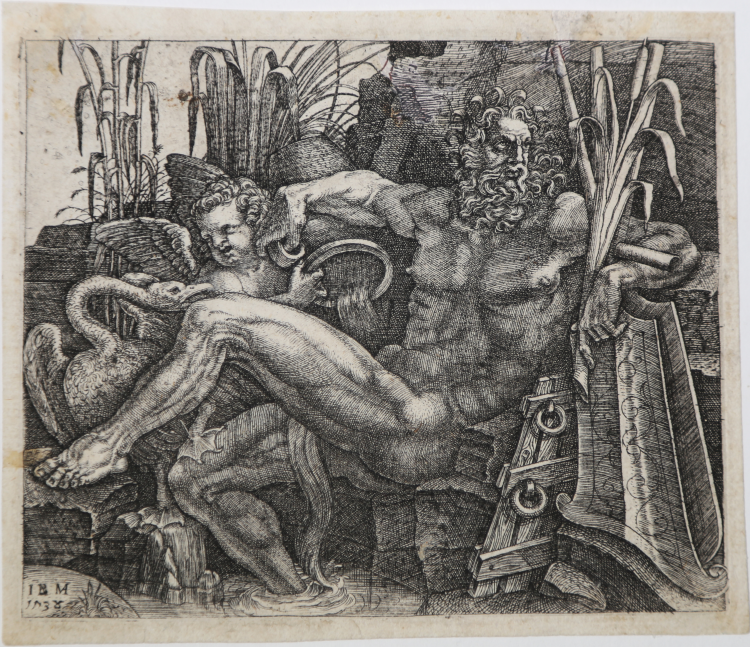




| Reference: | S36941 |
| Author | Giovanni Battista SCULTORI |
| Year: | 1538 |
| Measures: | 134 x 112 mm |



| Reference: | S36941 |
| Author | Giovanni Battista SCULTORI |
| Year: | 1538 |
| Measures: | 134 x 112 mm |
Engraving, 1538, monogrammed and dated on plate at the bottom left corner IBM/1538. After Michelangelo. Example of the second state of two.
A very nice impression, printed on contemporary laid paper without watermark but datable to the first half of the sixteenth century, with small margins, in excellent condition.
According to some scholars, the composition is a Scultori's invention, while for others it comes from Luca Penni.
Recent studies identify the subject as the detail of the River Eridiano in the Fall of Phaeton by Michelangelo. Exponent of the school Valance '500, the Sculptor is also known by the names of Ghisi and Bertano. A pupil of Giulio Romano, was primarily a painter, devoted to graphic art only in the period between 1536 and 1540.
The high quality of his works, extraordinarily close to the spirit of Giorgio Ghisi, have mistakenly contributed to believe that the two artists were relatives.
|
Bartsch 19, Massari 5 II/II, Rotili, Fortuna di Michelangelo nell’incisione, p. 76.
|
Giovanni Battista SCULTORI (Mantova 1503 - 1575)
|
Italian family of artists.specialized in engraving, and their association with Giorgio Ghisi, the leading Mantuan engraver of the time, led Vasari and subsequent authorities mistakenly to assume that their surname was Ghisi. Giovanni Battista Scultori worked in the studio of Giulio Romano, who was in Mantua from 1524 to 1546. Between 1536 and 1540 Scultori engraved 20 plates according to Bartsch, or 21 according to Albricci, most of which bear the monogram IBM. His style of engraving has its roots in that of Marcantonio Raimondi, probably through study with Raimondi's follower Agostino dei Musi, who was in Mantua c. 1530. The sources of the prints are almost all Scultori's own designs or drawings by Giulio Romano. Most of the subjects are Classical or military rather than religious and show a preoccupation with detail. Scultori came to engraving when he was already an accomplished draughtsman and sculptor, and his prints have a vigorous, sculptural quality with deeply cut lines that exaggerate tonal contrasts. Scultori apparently taught Ghisi, whose early work shows his influence and who engraved two plates of subjects from the Trojan Wars after his designs. He also trained his son Adamo Scultori and daughter Diana Scultori in engraving, but neither of them possessed the talent, vigour or originality of their father.
|
|
Bartsch 19, Massari 5 II/II, Rotili, Fortuna di Michelangelo nell’incisione, p. 76.
|
Giovanni Battista SCULTORI (Mantova 1503 - 1575)
|
Italian family of artists.specialized in engraving, and their association with Giorgio Ghisi, the leading Mantuan engraver of the time, led Vasari and subsequent authorities mistakenly to assume that their surname was Ghisi. Giovanni Battista Scultori worked in the studio of Giulio Romano, who was in Mantua from 1524 to 1546. Between 1536 and 1540 Scultori engraved 20 plates according to Bartsch, or 21 according to Albricci, most of which bear the monogram IBM. His style of engraving has its roots in that of Marcantonio Raimondi, probably through study with Raimondi's follower Agostino dei Musi, who was in Mantua c. 1530. The sources of the prints are almost all Scultori's own designs or drawings by Giulio Romano. Most of the subjects are Classical or military rather than religious and show a preoccupation with detail. Scultori came to engraving when he was already an accomplished draughtsman and sculptor, and his prints have a vigorous, sculptural quality with deeply cut lines that exaggerate tonal contrasts. Scultori apparently taught Ghisi, whose early work shows his influence and who engraved two plates of subjects from the Trojan Wars after his designs. He also trained his son Adamo Scultori and daughter Diana Scultori in engraving, but neither of them possessed the talent, vigour or originality of their father.
|